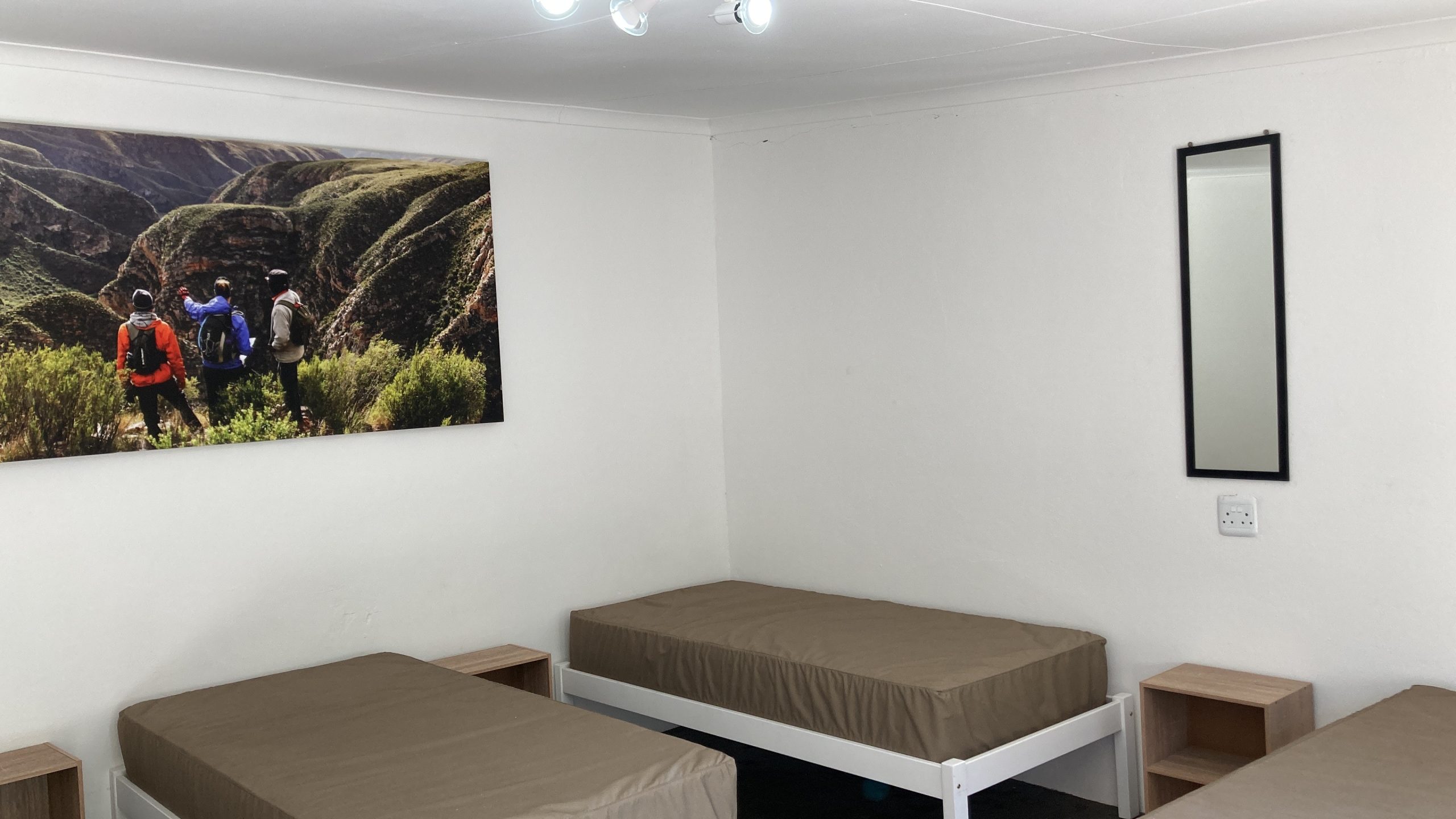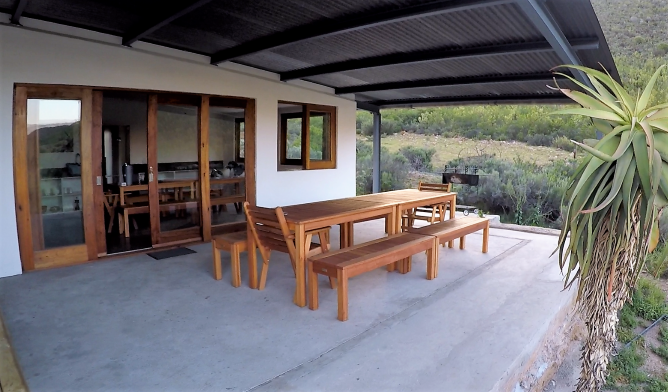Backpackers
Self catering Backpackers, R600 per room per night, bedding and towels not provided.
Situated at reception area where the Leopard trail starts and finishes, this is the perfect base to book for the night before and the night after you hike. The Backpackers consists of three separate rooms each with their own entrance. Each room has 4 single beds, solar power for lights and charging electronic devices, and a safe for valuables.
There is one communal bathroom with toilets and hot gas showers. There is a large, well equipped shared kitchen with gas fridge/freezer, gas stove top, hot running water and wash facilities. Connected to the kitchen is a covered veranda with a portable braai as well as a fire pit.
The rate is R600 per room per night – please bring your own sleeping bags, bedding and towels.
You can find relief on hot days in the large cement reservoir swimming pool that is available to all guests at Cedar Falls, fed by clear, fresh water from the mountain stream.
Please note that as we are in a World Heritage Site, we are unable to accommodate pets.
Check in is anytime from 3pm onwards, and check out by 9am. Guests are welcome to arrive earlier and leave later if you want to do walks, however please ensure you are out of your accommodation so that our team can start cleaning for the next guests.
Other Accommodation Options at Cedar Falls
No Results Found
The page you requested could not be found. Try refining your search, or use the navigation above to locate the post.
Visitors Book
Amber, August 2018
The Baviaanskloof is an extremely beautiful place. Thank you for hosting us. Willem’s service toward us was excellent & how very humble & willing he is. Thank you so much for this too
Jacques Marais talks up the Leopard Trail in his latest book
*** A special thanks to Jacques Marais for including the Leopard Trail in your book “More things to do in Moer and Gone Places”. www.jacquesmarais.co.za
Here is a snippet from his book:
The destination
Province – Eastern Cape
Closest Town – Willowmore (84km)
Destination – Baviaanskloof
Baviaanskloof – the name is derived from the Dutch for “Valley of Baboons” – is a narrow valley blessed with pristine natural grandeur, and run with narrow gorges, streams, steep mountain passes and vast waving grassland plains.
The valley is just under 200 km in length, and encompassed by the Baviaanskloof Mountains to the north and the Kouga mountains to the south. The Valley itself lies at a lower altitude than the Karoo to the north. Intensified rainfall from the Karoo filters into the Baviaanskloof, making it a lush landscape supporting a wide variety of fauna and flora.
The Leopard Trail Hike is a moderately difficult four-day, three night slackpacking hike and is suitable for people with good hiking fitness. Along the way you will encounter a few steep and rocky ascents and descents, with intermediate daily distances for the duration of the hike.
The hike itself follows a circular route from the Cedar Falls Base Camp. The trail starts Day 1 (9.2 k, 3 – 5hours) with quite a stiff walk up Kick-Start Hill to the plateau. At the half-way mark, you can opt to take a detour to Gabriel’s Pools where you can have a swim in the small pools. This is the only place to get drinking water during the day. The detour is 570m each way, so think of adding an hour to the hike for the day.
Day 2 (18km, 5 – 8 hours) starts with an easy 5.5km walk along Rhebok Valley. At the end of the valley, there is another optional detour (314m each way) to the Cedars viewpoint. On the way, there is a stream with drinking water and a pool in which to cool down. From the detour point, the trail climbs up to the top of the saddle where you will have breathtaking views of the Kouga and Baviaans foothills before dropping down to the Reflection Pools where you can swim and top up your drinking water.
Day 3 (22km, 6-9 hours) is the longest day of the hike. The trail leads you through pristine wilderness deep in the heart of the Baviaans and Kouga mountain landscape towards three major climbs: Honeybush Hill, Inconvenient Truth and Ain’t So Bad. At the half-way point, Draaipunt, there is yet again a 224m detour for drinking water. The remainder of the day is spent walking down the incredibly beautiful Kosey Kloof for 9km to the third overnight spot.
Finally, on Day 4 (12km, 3-5 hours) you’ll set off through the beautiful Birdsong Valley, only to reach Fond Farewell, a steep climb to the plateau after 4km. Once on the plateau, the trail leads through the Cauldron, a series of two small valleys followed by a steep descent into the Cedar Falls alley, which brings you back to base camp.
The accommodation
This is a slackpacking hike, but you have to bring your own tent, mattresses and sleeping bags; these are then transported from campsite to campsite in time for your arrival, so all you have to carry is a daypack with food and drink.
Overnight sites have a catering tent that provides a communal space for protection from sun, wind and rain. Each tent has a table, some benches, a sink and a twin gas cooking plate. Camping sites have been cleared around the catering tents. Overnight camps are equipped with pots, pans, braai grids, crockery and cutlery. Water is piped from the mountain streams into water tanks.
Types of Accommodation: Self-Catering
Camping: Yes – maximum 12 tents
Caravanning: No
Alternative Accommodation
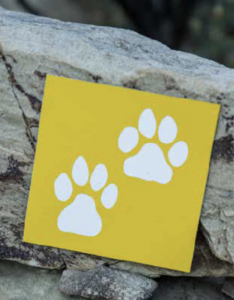
Red Cliffs Farmhouse is an ideal base for hikers. The farmhouse is built around a 150-year-old stone-wall room that has been added on to and expanded over the years and now provides a tranquil refuge in the kloof. The large open-plan lounge has a fireplace for the cold winter nights. Four bedrooms can sleep up to 12 people. Linen and towels are supplied by prior arrangement. Accommodation is in two rooms with a king-sized bed in each, one room with six single beds, and one room with two single beds. There are two bathrooms, one with a shower and one with a bath.
Cedar Farmhouse sleeps eight, with bedding and towels supplied. Sleeping options include one double room with a king-size bed and three twin rooms with two single beds in each. There are two bathrooms and a private outside shower, spacious lounge, well-equipped kitchen and an old-fashioned wraparound veranda. The indigenous garden has a braai area.
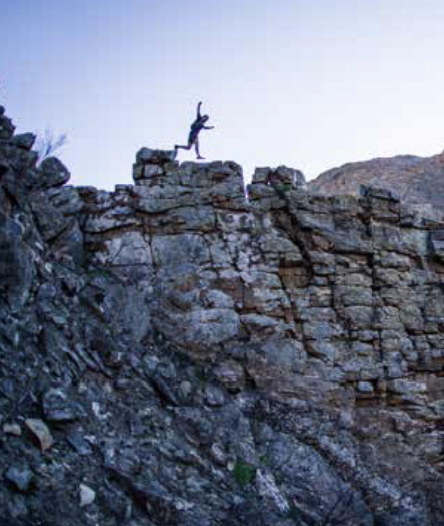
Reasons to visit
The Baviaanskloof Wilderness Area is one of the most rugged and beautiful places in the country, with pristine wilderness, spectacular mountain passes and abundant wildlife, including the inevitable troops of baboons after which the area was named.
Go hike
In addition to the Leopard Trail, The Cedar Falls Day hike should not be missed. The trail meanders alongside clear flowing streams inside beautiful kloofs. Starting and ending at Cedar Falls Base Camp, it will take 4- 6 hours (including lunch and swim stops). At two points along the trail, you will have to swim a few metres to get through a narrow gorge. If hiking in winter, be aware that the water will be very cold.
Go view San Paintings
The guided San Rock Art Walk is only available to guests staying overnight at the Cedar Falls Base Camp. The two-hour trip (45 minutes each way, with half an hour at the caves) takes you through the Leopard Kloof Valley to the San cave where the stunning Running Man painting is found. A 30cm image of a medicine man, wearing a mask and carrying hunting sticks, dominates the paintings.
Go run
The Leopard Trail Run is a circular two-day run, using the path of the four-day Leopard Trail Hike. Runners combine days 1 and 2 into a one day and days 3 and 4 into a second day. The trail is along a single track path and is 70% runnable, but care must be taken on the remainder due to steep ascents and descents where there is loose material on the path (more info at www.ecobound.co.za).
Go crank
The attraction of the Baviaanskloof is best experienced on a multiday cycle ride, with overnight stops at self- catering farm cottages or campsites along the way. Spending time at Geelhoutsbos, Rooihoek and other hideaway spots along the way is a must. You may, however, feel the need for company if you plan on tackling this monster, and the best way of doing this would be to enter the annual Trans-Baviaans 24-hour MTB marathon. This event finishes near Jeffreys Bay and totals 230km – more info on www.transbaviaans.co.za .
Important info
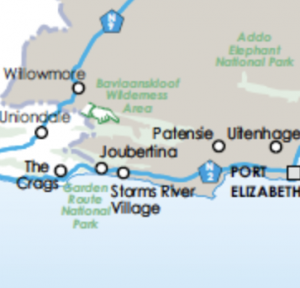
Find your way: From Willowmore, take the N9 towards Uniondale. After 3km out of Willowmore take the road on the left signposted “Baviaanskloof”. Keep going straight on this road for 31km, at which point you enter the Nuwe Kloof Pass. Drive a further 7.4 km to a road on the right marked “Cedar Falls”. Drive 7km to Cedar Falls Base Camp.
Access: Gravel Roads
Cell Reception: Intermittent
GPS Coordinates: S33°34’31.28” ; E23 42’57.33”
Website: www.gobaviaans.co.za
Tel: +27 (0)74 939 4395
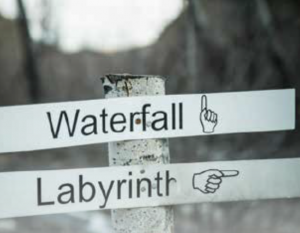
Recovery well on the way after the fires
As most of our friends know, a mountain fire swept through our section of the Baviaanskloof in December. As sad as it was to see the land burnt and as wonderful as it is to watch the veld recover, we must accept that fires here are a natural phenomenon, and an important ecological process in the fynbos ecosystem.
It is the magic and beauty of this ecosystem and landscape that makes the Leopard Trail such an iconic trail in South Africa, and we accept that fires of this nature are a part of our operating environment.
For some insight to the recovery of fynbos, here’s a timeline from the desk of the ecologist at The Eastern Cape Parks and Tourism Agency:
“Fire is normal in fynbos systems and many plant species require fire. It is the most important natural disturbance in fynbos biomes. Fire provides an opportunity for seedling establishment – most recruitment of seedlings in fynbos happens in response to a fire. As fynbos vegetation ages, there is a decline in diversity as the vegetation becomes tall and some species are shaded out. Fire is therefore required to maintain diversity.
“The response of fynbos vegetation to fire is complex. Plants have various fire survival strategies, principally divided into two groups: resprouting plants and reseeding plants. Resprouting plants often have insulating mechanisms to allow them to survive fire (for example, Protea nitida has thick bark on its stems that insulates buds from fire damage. Resprouters include plants that resprout from fire-resistant rootstocks, such as the grasses and species such from the Proteaceae (Leucadendron salignum, Protea cynaroides), Restionaceae (reeds) and Cyperaceae (sedge) families.
“After a fire, the vegetation will move through various stages until reaching its climax structure and composition – this is known as post-fire succession.
“Early stages are characterised by a high cover of grasses, the emergence of post-fire ephemerals and also flowering of geophytes. Resprouting of perennial shrubs occurs very quickly after the fire (within two weeks). With all the new growth, the veld looks very green. The rejuvenation of grasses after a fire is very important for the grazing mammals inhabiting mountain fynbos (such as Cape mountain zebra and red hartebeest).
“Fire stimulates flowering in certain species, especially in geophytes (plants with underground bulbs or tubers). This is largely due to the indirect effects of fire, such as changes in soil temperature and nutrient availability. In the Baviaanskloof, species that can be found flowering in response to a fire include Watsonia knysnana, W. schlecteri and W. wilmaniae, Boophane disticha, Brunsvigia josephinae, Cyrtanthus montanus, Haemanthus coccineus, Haemanthus sanguineus, Nerine humilis, Disa pillansii, D. porrecta and D. cornuta, Satyrium acuminatum and S. bicorne.
“Fire ephemerals are short-lived species that complete their life cycles in the period immediately after a fire. Germination is stimulated by fire. Species include Ursinia paleacea, Aspalathus spp., Thesium strictum and T. virgatum.
Some reseeding Erica species appear to have a delayed germination after fire and only appear after more than a year after a fire.
The reseeding Proteaceae are generally the slowest to mature and have long juvenile periods. For example, Protea neriifolia, P. mundii and P. repens take at least four years (often longer) to begin flowering in the Baviaanskloof.”
You can also an idea from this site: http://www.fynboshub.co.za/fynbos-diversity/when-the-smoke-settles-new-life-begins/
ABOVE: A little protea snapped on The Leopard Trail by Kobus Conradie in April 2017
Getaway Mag Does The Leopard Trail in Photos
Getaway magazine editor Sonya Schoeman & photographer Teagan Cunniffe walked our four-day hike last year.
See how Teagan captured their expedition in In Photos: Baviaanskloof’s Leopard Trail.
Trail Mag’s Leopard Trail Run Review
Last year passionate trail explorer Andy Wesson did our challenging two-day trail run in one day. Respect!
This year, he and his mates are doing it again, from the other direction. We’ll let you know how he finds it.
You can download and read his review in TRAIL mag here:
TRAIL Mag review of Leopard Trail Run 2016
Discover what’s in the latest issue of TRAIL mag, and keep up to speed by following them on Twitter and Facebook.
Getaway Magazine’s cover story on the Leopard Trail
This article is full of humour and grit as the Getaway team come to grips with the heat and beauty of the Leopard Trail. We love it when the writing matches the landscape – beautiful, truthful and crafted through years of hard work.
“And finally I’m standing on top of the world, incredulous at what I’ve achieved, and marvelling at the exquisite, untouched world around me, while a pair of eagles soars close by, judging life and death below. I think to myself, I’ve walked through a story about the land, the people, the creatures, the heartbreak they’ve all faced, the hope and philosophy and exquisite landscape. And then I turn and take one step, and then another step and then another…”
Here are the introductory paragraphs, and we suggest you read the rest yourself at the link below:
“The Baviaanskloof is known for its hoards of baboons. It is, in fact, what Baviaanskloof means: the valley of baboons. These four-legged rascals are splendidly adapted to this phalanx of bony orange rocks that jut out into the vivid blue sky. But in four days we see only one – even baboons have the sense to exert as little energy as possible here at midday in the height of summer. Not us, though. No. It’s day one, 2pm, and there we are, trudging up a deeply rutted stony former truck track, and with each crest another appears, higher, longer – endless. It doesn’t take long to sift the wheat from the chaff, and the chaff is me and an Irishman in his seventies who has walked the entire Camino de Santiago, but is now off to one side making an alarming wheezing sound. My own face is puce, my head throbs and I’m so overheated I want to throw up. Whose idea was this?
Linden Booth is strolling in front of me, chatting comfortably, cool as a Bishop’s old boy at a polo match. It was his idea to buy a farm in the furthest corner of the Baviaanskloof. His idea to create this murderous hike. His idea to leave at 2pm, when the sun is at its most vicious. His idea to tell us we would be just fine, I would be fine. But I’m so not fine. I’m doubled over, with barely the presence of mind to twist open my Stanley flask and pour out some iced mint water that I sip at like I’m on my deathbed – any kind of bed will do at this point. I’m an atheist, but this could be the turning point. I send up a prayer, then remember that I have blasphemed up every inch of this God-damned track; I’m going to hell! Except this already feels like Satan’s domain.”
Read about all the trail and Sonya’s experience in Why You Should Walk the Baviaanskloof’s Leopard Trail.
